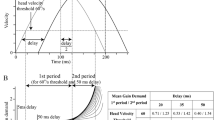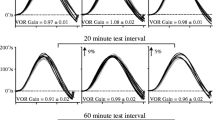Abstract
The primary function of the vestibuloocular reflex (VOR) is to maintain the stability of retinal images during head movements. This function is expressed through a complex array of dynamic and adaptive characteristics whose essential physiological basis is a disynaptic arc. We present a model of normal VOR function using a simple neural network architecture constrained by the physiological and anatomical characteristics of this disynaptic reflex arc. When tuned using a method of global optimization, this network is capable of exhibiting the broadband response characteristics observed in behavioral tests of VOR function. Examination of the internal units in the network show that this performance is achieved by rediscovering the solution to VOR processing first proposed by Skavenski and Robinson (1973). Type I units at the intermediate level of the network possess activation characteristics associated with either pure position or pure velocity. When the network is made more complex either through adding more pairs of internal units or an additional level of units, the characteristic division of unit activation properties into position and velocity types remains unchanged. Although simple in nature, the results of our simulations reinforce the validity of bottom-up approaches to modeling of neutral function. In addition, the architecture of the network is consistent with current ideas on the characteristics and site of adaptation of the reflex and should be compatible with current theories regarding learning rules for synaptic modification during VOR adaptation.
Similar content being viewed by others
Abbreviations
- D :
-
net discharge rate of motorneurons
- E p :
-
eye position
- F e :
-
network error function
- k :
-
elastic coefficient
- lagx :
-
time lag between units
- LEBP:
-
eyeball position signal
- N1x :
-
primary afferent type units
- N2xi :
-
VN Type I units
- N2xii :
-
VN Type II units
- N3LRx :
-
oculomotor units — lateral muscles
- N3MRx :
-
oculomotor units — medial muscles
- N4xi :
-
neural integrator Type I units
- N4xii :
-
neural integrator Type II units
- r :
-
viscosity coefficient
- s :
-
Laplace transform operator
- T :
-
time constant
- VN:
-
vestibular nucleus
- VOR:
-
vestibuloocular reflex
- w d :
-
unit decay factor
- w eji :
-
excitatory connection strength
- w ki :
-
inhibitory connection strength.
References
Arnold DB, Robinson DA (1991) A learning network model of the neural integrator of the oculomotor system. Biol Cybern 64:447–454
Bremermann H (1970) A method of unrestrained global optimization. Math Biosci 9:1–15
Cannon SC, Robinson DA (1985) An improved neural-network model for the neural integrator of the oculomotor system: more realistic neuron behavior. Biol Cybern 53:93–108
Cannon SC, Robinson DA (1987) Loss of the neural integrator of the oculomotor system from brain stem lesions in monkey. J Neurophysiol 57:1383–1409
Cannon SC, Robinson DA, Shamma S (1983) A proposed neural network for the integrator of the oculomotor system. Biol Cybern 49:127–136
Cheron G, Godaux E, Laune JM, Vanderkelen B (1986) Lesions in the cat prepositus complex: effects on the vestibulo-ocular reflex and saccades. J Physiol (London) 372:75–94
Collewijn H, Grootendorst AF (1979) Adaptation of optokinetic and vestibulo-ocular reflexes to modified visual input in the rabbit. Prog Brain Res 50:771–781
Delgado-Garcia JM, Vidal JJ, Gomez C, Berthoz A (1989) A neurophysiological study of prepositus hypoglossi neurons projecting to oculomotor and preoculomotor nuclei in the alert cat. Neuroscience 2:291–307
Galiana HL (1986) A new approach to understanding adaptive visual-vestibular interactions in the central nervous system. J Neurophysiol 55:349–374
Gauthier GM, Robinson DA (1975) Adaptation of the human vestibuloocular reflex to magnifying lenses. Brain Res 92:331–335
Gonshor A, Melvill Jones G (1976a) Extreme vestibulo-ocular adaptation induced by prolonged optical reversal of vision. J Physiol (London) 256:381–414
Gonshor A, Melvill Jones G (1976b) Short-term adaptive changes in the human vestibulo-ocular reflex arc. J Physiol (London) 256:361–379
Grossberg S (1973) Contour enhancement, short term memory and constancies in reverberating neural networks. Study Appl Math 12:213–257
Harrison REW, Baker JF, Isu N, Wickland CR, Peterson BW (1986) Dynamics of adaptive change in vestibulo-ocular reflex direction. I. Rotations in the horizontal plane. Brain Res 371:162–165
Ito M (1982) Cerebellar control of the vestibulo-ocular reflex — around the flocculus hypothesis. Annu Rev Neurosci 5:275–296
Khater TT, Quinn KJ, Baker JF, Peterson BW (1991) Latency of adaptive VOR shows responses which are dependent on the length of adaptation. Soc Neurosci (abstr) 127.8:313
Lisberger SG (1988) The neural basis for the learning of simple motor skills. Science 242:771–773
Lisberger SG, Miles FA, Optican LM (1983) Frequency-selective adaptation: evidence for channels in the vestibulo-ocular reflex? J Neurosci 3:1234–1244
Lockery SR, Wittenberg G, Kristan WB, Cotrell GW (1989) Function of identified interneurons in the leech elucidated using neural networks trained by back-propagation. Nature 340:468–471
Melvill Jones G (1977) Plasticity in the adult vestibulo-ocular reflex arc. Phil Trans R Soc London Ser B 278:319–334
Melvill Jones G (1985) Adaptive modulation of VOR parameters by vision. In: Berthoz A, Melvill Jones G (eds) Adaptive mechanisms in gaze control. Facts and theories. Elsevier, New York, pp 21–50
Miles FA, Eighmy BB (1980) Long-term adaptive changes in primate vestibuloocular reflex. I. Behavioral observations. J Neurophysiol 43:1406–1425
Peterson BW, Baker JF, Houk JC (1991) A model of adaptive control of vestibuloocular reflex based on properties of cross-axis adaptation. Ann NY Acad Sci 627:319–337
Pola J, Robinson DA (1978) Oculomotor signals in medial longitudinal fasciculus of the monkey. J Neurophysiol 41:245–259
Powell KD, Quinn KJ, Rude SA, Peterson BW, Baker JF (1991) Frequency dependence of cat vestibulo-ocular reflex direction adaptation: single frequency and multifrequency rotations. Soc Neurosci (Abstr) 127.20:315
Quinn KJ, Schmajuk N, Rude SA, Baker JF, Peterson BW (1991) Multiplicative learning rules simulate properties of VOR plasticity. Soc Neurosci (Abstr) 127.15:314
Robinson DA (1981) Control of eye movements. In: Brookhart JH, Mountcastle VB (eds) Handbook of physiology. American Physiological Society, Bethesda, pp 1275–1320
Robinson DA (1989) Integrating with neurons. Annu Rev Neurosci 12:33–45
Rude SA, Baker JF (1988) Dynamic otolith stimulation improves the low frequency horizontal vestibulo-ocular reflex. Exp Brain Res 73:357–363
Schultheis LW, Robinson DA (1981) Directional plasticity of the vestibulo-ocular reflex in the cat. Ann NY Acad Sci 374:504–512
Skavenski AA, Robinson DA (1973) Role of abducens neurons in vestibuloocular reflex. J Neurophysiol 36:724–738
Williams RJ, Zipser D (1990) Gradient-based learning algorithms for recurrent connectionist networks. Technical Report NU-CCS-90-. Northeastern University, Boston
Wilson VJ, Melvill Jones G (1979) Mammalian vestibular physiology. Plenum Press, New York
Zipser D, Andersen RA (1988) A back-propagation programmed network that simulates response properties of a subset of posterior parietal neurons. Nature 331:679–684
Author information
Authors and Affiliations
Rights and permissions
About this article
Cite this article
Quinn, K.J., Schmajuk, N., Jain, A. et al. Vestibuloocular reflex arc analysis using an experimentally constrained neural network. Biol. Cybern. 67, 113–122 (1992). https://doi.org/10.1007/BF00201018
Received:
Accepted:
Issue Date:
DOI: https://doi.org/10.1007/BF00201018




